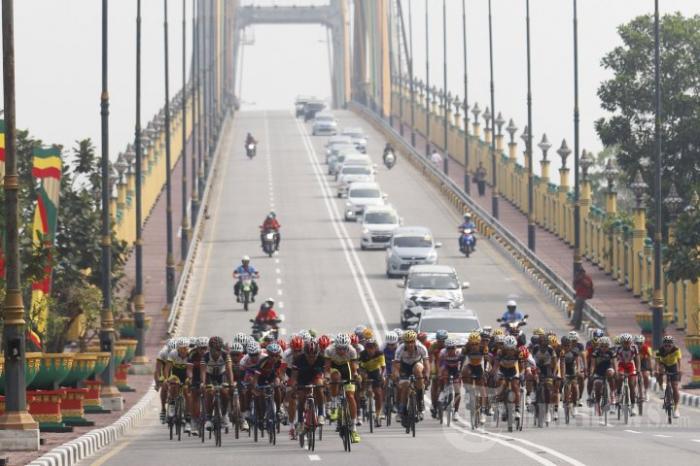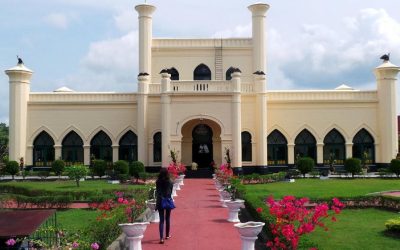Home / Batik Regions – Western Indonesia – Northern Sumatra – Riau / Tour de Siak – World Cycling Race
Cultural Destination
Embrace the spirit of the place!
Tour de Siak – World Cycling Race
Tour De Siak is an annual international bicycle racing activity consisting of 3 stages with a route length of 542 km. Joining this championship will not only allow you to discover the natural beauty of Riau, but also enjoy cultural performances and local culinary at each stop. Every year around 16 countries participate in this event. Further information can be accessed at Union Cycliste International.
Tourist Attractions in Riau
Siak Historical Palace
The Sri Indrapura Siak Kingdom was the largest Islamic Malay kingdom in
Riau
Batik Motifs
Tabir Tanjung
Tanjung flower is a type of Cherry tree flower, which is commonly found in
Kasih Tak Sampai
‘Kasih Tak Sampai’ is an idiom in the Indonesian language which refers to
Pucuk Rebung Riau
Pucuk Rebung symbolizes heart determination in achieving goals, good luck, and
Discover
Indonesian
Batik
Motifs
Merak Ngeram
The hatching peacock motif has a very deep meaning which refers to the sacrifice and
Paqbarre Allo
The word “Barre” means round and “Allo” means the sunlight. This motif is interpreted as
Desa Na Tolu
The Desa Na Tolu characteristic pattern symbolizes the Batak philosophy of existence and
Wirasat
Wirasat or divine inspiration is a gift from God. This inspiration is symbolized by
Raja Ampat
Raja Ampat motif represents the marine life at Raja Ampat archipelago in
Awan Berarak
Awan Berarak is a combination of Dayak motifs and Malay patterns. The word ‘Awan Berarak’ means the
Pucuk Rebung Riau
Pucuk Rebung symbolizes heart determination in achieving goals, good luck, and
Parang Seling
Parang Seling or “alternating daggers” is a royal batik motif. It is a feminine variant of
Sido Mulyo
Sidomulyo is one of the classical motifs, which is specifically used for the bride’s costume in
Pati-Pati Pinehiku
It symbolizes the hierarchy in society and the social status of the Mekongga
Insang Ikan
Insang refers to the gills of the fish. This is a typical pattern of Malay ethnic who inhabits
La Galigo
La Galigo is a literary work of the Buginese Epic that has 300 thousand epic lines. It is considered even
Salakanagara
Salakanagara batik motif illustrates the first kingdom in the Betawi land
Ikan tambal
The word “Ikan” refers to fish. The philosophical meaning of Ikan Tambal means is
Biji Kopi
The coffee seeds motif illustrates the pride of local coffee specialities in
Leuit Sijimat
This motif reflects the daily activities of the Baduy tribe in Banten. The main ornaments of batik motif consist of:
Malinau Cultural Festival
You will witness a unique competition that might not be found other than in
Rangkiang
The word “Rangkiang” refers to the rice granary in the Minangkabau language. It symbolizes
Manguni Minahasa
Manguni is identified as the symbol of the Minahasa people. Manguni is known as a
Tifa Totobuang
The batik motifs illustrate Maluku’s traditional music instrument called
Angsa Duo
According to legend, the Angso duo batik motif is a pair of swans that are believed to have led Princess
Daun Sirih
This motif illustrates betel leaves that are used by Lombok communities as traditional
Tenun Bima
The motifs are adopted from Bima woven textile. This pattern has received a great
Teguh Bersatu
This batik motif shows the strength of the people of Kupang. It also represents a sense of
Kuda Kupang
Horses symbolize wealth. It contains noble values of virtuous characters that bring
Kasih Tak Sampai
‘Kasih Tak Sampai’ is an idiom in the Indonesian language which refers to
Sandeq
Sandeq Boat is a symbol of the maritime importance of the West Sulawesi region. The greatness of
Srimanganti
The name of the Srimanganti motif is derived from Palace’s hallway that connects to
Besurek Rembulan
This batik illustrates praise for God who created the wonderful universe
Sero Tangga
The Sero Tangga illustrates an endearing feeling and sacrifices of a person to fulfil
Cengkeh
The clove flower motif is the main commodity of the Tolitoli Regency. This motif represents
Burung Bidadari
Bidadari birds are endemic birds in Halmahera. This motif represents an
Bultiya
The word ‘Bultiya’ is an acronym of the three major tribes in North Kalimantan, namely
Tubo Kelapa
Coconut tree is a symbol of a good character and strong mentality. It illustrates the more success a person, the more
Besurek Rafflesia
The term “Basurek” refers to a textile that contains letters or inscriptions
Tikar Natuna
The Tikar Natuna motif is adapted from the traditional making of pandanus mats in
Lontara
The Lontara script itself is a typical ancient script of Bugis and Makassar communities. History records that
Gajah Way Kambas
The motif illustrates the Lampung’s natural reserve, the Way Kambas. it also symbolizes
Wakatobi
It symbolizes the coastal beauty of the Wakatobi island and the symbol of Patra symbolizes
Buketan Bali
The Balinese bouquet (Buketan Bali) is a floral arrangement and the name is
Tabir Tanjung
Tanjung flower is a type of Cherry tree flower, which is commonly found in
Gumin Tambun
Based on Hindu mythology, this motif symbolizes lucks, abundant wealth, and
Lok Baintan Floating Market
As you can imagine, the most authentic thing is that you can buy things and even
Tengkawang Ampiek
With its many advantages, the Dayaks use this leaf in ritual ceremonies. This plant is a symbol of
Hiu Taliyasan
Indonesia is also home to the world’s largest fish, the whale shark (Rhincodon typus). Hiu Taliyasan refers to
Pohon Hayat (Tree of Life)
The Batik motifs in Lampung are dominated by the acculturation of Buddhist and
Gamolan
This motif illustrates Gamolan, a bamboo musical instrument of Lampung that is
Dayak Kamang
Kamang motif is generally found in the Dayak tribe shield because it is believed to
Durian Pecah
Broken Durian motifs depict the foundation of faith. The second half signifies the mastery of
Tangerang Herang
Tangerang Herang motif is a symbol of Tangerang city. The Tangerang Herang batik motif consists of
Rumah Mamuju
the Batik motif illustrates the house of Mamuju King with the stairs, located on the left of the wooden stage house
Gentala Arasy
Built as high as 80 meters, the tower also highlights the historical side of
Sekar Jati
Sekar means flower and Jati refers to teak trees that symbolizes a strong mental character that
Bintik Tujuh
The Bintik Tujuh (Seven Dots) motif has 7 white spots and green color gradation as
Ake Patra
Ake is related to the divinity and the composition of the universe. It is a symbol of
Tanah Liek
The word “Tanah Liek” refers to clay in Minang language. It is also known as
Pattimura
Pattimura is the name of an Indonesian hero who fought against colonialism in
Bomba Mawar
This motif means sacred love for family, kingdom, and God; It also illustrates
Karawo Mahkuta
Mahkuta refers to Gorontalo’s traditional crown. It represents noble characters of
Daun Lada Hitam
The black pepper motif represents the main commodity of Bangka Belitung
Bale Lumbu
This motif signifies the welfare of the ancient Sasak society. Bale also symbolizes the
Karawo Pinang
Pinang refers to the Palm areca tree. This motif is considered as the original
Kaharingan
The Kaharingan or ‘tree of life’ based on the Dayak tribes’ belief system. This tree symbolizes
Jupri Kembang Teh
Kembang Teh illustrates the tendrils of tea plants that grow in the highlands of
Tongkonan
Toraja’s traditional house is called Tongkonan. Tongkonan is a place for
Kain Cual
Cual textile tradition has existed since the 17th century. The word “Cual” refers to
Prada Papua
The word “Prada” in the Javanese-Indonesian dialect means a batik textile that
Pinawetengan
The Pinawetengan Batik pattern was taken from a prehistoric inscription in
Lipaq Sabe
Lipaq Saqbe contains a simple geometric classical motif with various flower decorations. This textile is
Gigi Haruan Lidi
The Gigi Haruan Lidi motif is taken from the name of the cork fish and is a symbol of
Pala Salawaku
This motif illustrates the unique weapons of the Maluku region, namely
Honai
The Honai is inspired by the traditional house of the Papuan community living in


